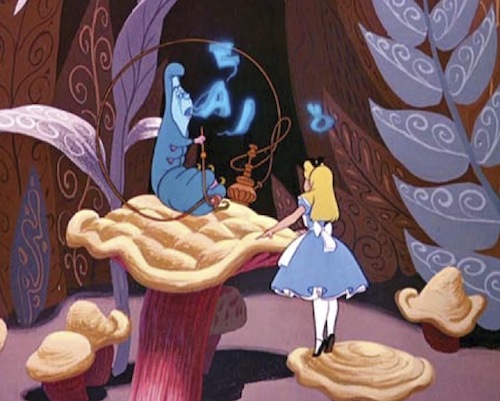article
Fall 2010 Guide: Curiouser and Curiouser (and Curiouser)
SEP 1, 2010
Laura Henry discusses the evolution of the story of Alice in Wonderland.
Don’t let the hookah-puffing caterpillar fool you. Alice in Wonderland is a simple tale of growing up—one of a million stories with the same doubts and dilemmas. Why, then, do we keep telling this one?
It’s not the plot of Alice that captivates us, but its imagination. Many writers have whined about the pitfalls of puberty, but Lewis Carroll transformed trauma into art. He created an alien world that has become as familiar as our own—a world where we are strangers, yet know every crooked path. Wonderland taught us to embrace the absurd. Why shouldn’t cards use flamingoes as croquet mallets?
Alice transforms as often as Alice herself. Carroll’s tale has been a novel and a film, a cartoon and a puppet spiel, a Broadway musical and an avant-garde phantasmagoria. So many artists in so many mediums have been drawn to this story because Wonderland is a blast of imagination, a world that defies logic. At the same time, Wonderland presents a challenge. Every time an artist enters this magic realm, he or she must compete with a formidable tradition.
It didn’t take long for Alice to inspire adaptation. Alice’s Adventures in Wonderland appeared in 1865; Through the Looking-Glass in 1871. Since 1903, there have been at least twenty films, attracting celebrities from W.C. Fields to Johnny Depp. The early films imitated John Tenniel’s illustrations of the book. These pictures, flavored with a Victorian flair for serious nonsense, defined the image of Alice for generations.
Walt Disney’s Alice in Wonderland (1951) broke free of Carroll and Tenniel. Disney adored Alice, and he worked on his film adaptation for eighteen years. While Carroll’s novel is a series of episodes, Disney knew a film audience needed rising action and a thrilling climax, so he trimmed, and changed, and added a chase scene.
Most importantly, Disney exploited animation to capture the sparkle of Carroll’s imagination. A dazzling parade of figures swirls through the film: a Busby Berkeley pirouette of cards; a cat linking and unlinking his own purple stripes; a caterpillar shuffling his words inside speech bubbles. His visual and verbal puns recall Carroll’s wordplay. Several sequences bear the influence of Salvador Dalí, who had recently worked with Disney on a short film entitled “Destino.” Though unpopular when first released, critics have since lauded Disney’s artistry in Alice in Wonderland.
Puppet Alice made her screen debut in 1988, with Jan Svankmajer’s Alice. The opening credits proclaim, “A film for children. PERHAPS!” Svankmajer’s adaptation turns the absurdity of Carroll’s work into political commentary on the Soviet domination of Czechoslovakia. Using stop-motion photography and an army of dolls, trash, and toys, Svankmajer’s film delights and terrifies.
His Wonderland is a maze of grimy rooms and tunnels, filled with skulls and sawdust, raw meat and dead leaves. A taxidermied White Rabbit pulls his watch out of his gaping chest cavity and peers at it with bulging plastic eyes. Alice is lost in a squalid Czech tenement, chased by chicken skeletons and mice. Many saw Svankmajer’s film as an allegory for current events: a disenchanted generation rebelling against an absurd regime.
Most recently, film director Tim Burton confronted the challenge of Alice. His version is a story of female empowerment. Down the rabbit hole, nineteen-year-old Alice doesn’t just wander, she gets involved: she rescues the Mad Hatter from prison, pilfers the Queen’s ferocious Bandersnatch, and confronts the Jabberwocky. Rather than giving in to circumstances, this Alice chooses her own path. An active Alice gives motion to the plot and enlivens Burton’s rich visuals.
Alice has transformed frequently on stage as well as screen. Andre Gregory’s Alice in Wonderland exemplified the turbulent theater of the counterculture. The 1970 production drew heavily on the methods of theater director Jerzy Grotowski, an advocate of intense physicality who believed the twisting, turning body of the actor should express pain and exaltation.
In Gregory’s Wonderland, nothing kept its shape for long. The caterpillar lounged on the backs of four actors. Their torsos formed the mushroom, and one of their thumbs served as his hookah. Bodies huddled on top of each other created the rabbit hole that swallowed Alice. The actors constantly transformed, molding croquet balls and wickets, trees and balloons. Gregory’s Alice created a dream state, bringing to life the joy and terror of childhood.
Visionary director Robert Wilson adapted Alice’s story in 1992. With music by Tom Waits, the production wove together the biography of Lewis Carroll (whose real name was Charles Dodgson) with characters from Alice. Wilson explored the ambiguous relationship between the child Alice Liddell, the inspiration for Alice, and Dodgson, who took erotic photos of little girls.
Wilson staged Carroll’s obsession with Alice in haunting images: an enormous camera lens followed her across the stage, the swelling tail of a vaudeville caterpillar pursued her. In a sensuous, scarlet forest, an old, alcoholic Alice bewailed her abuses to her cat. Waits’s music and lyrics captured the pain of Wilson’s version: “Hang me in a bottle like a cat/ Let the crows pick me clean but for my hat.” Wilson’s production forced the audience to consider the sinister connotations of Carroll’s tale, dulling the glitter of Wonderland.
In Brendan Shea’s new adaptation receiving its U.S. premiere at the A.R.T. this fall, Alice’s story is a jumble of neon, guitars, and whirling lights. Alice vs. Wonderland is a kaleidoscope of music, color, and nastiness, all orchestrated by director János Szász, who invites us to follow Alice into Wonderland and re- experience the child-like joy in seeing a new world we’ve always known.
Laura Henry is a second-year dramaturgy student at the A.R.T./MXAT Institute for Advanced Theater Training at Harvard University.

